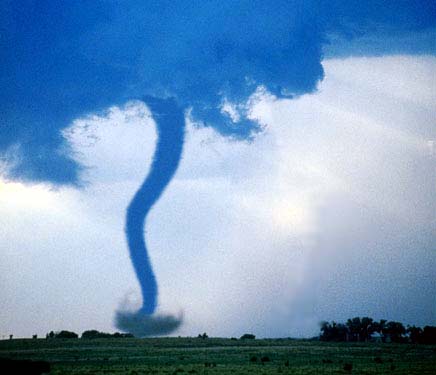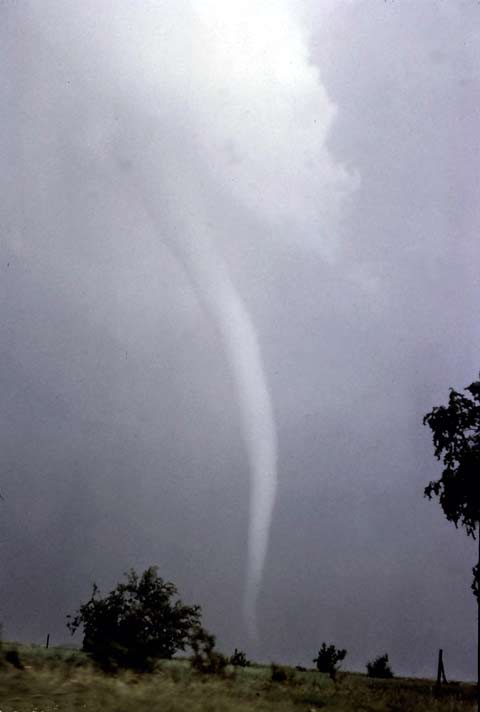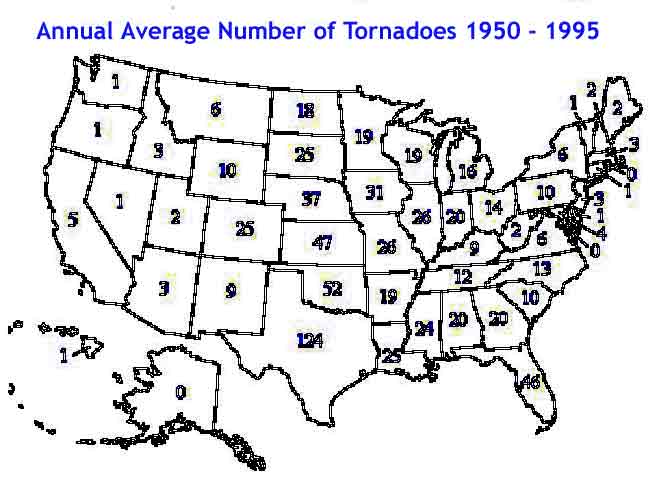Controlling the Weather
Memorable Tornado EventsBad weather always looks worse through a window. - Tom Lehrer
Tornadoes are low pressure systems, and can generate wind velocities exceeding 200 mph.
Deadliest Tornadoes
LiveScience / Source NOAA
Staying SafeIf a tornado strikes, the safest place is in a strong building - preferably in a basement or a small interior room. The important thing is to get away from windows and put as many walls as possible between you and the outside. Mobile homes do not provide adequate protection from a tornado. If there are no secure buildings nearby, lie flat with your hands over your head in a ditch or depressed area. Do not try to outrun a tornado in your car, experts say. Source: www.livescience.com 22 March 2005
Billion Dollar Weather Disasters in the USby Michael Schirber Heat DangerAs dramatic as the recent hurricanes have been, it is perhaps surprising that droughts and heat waves cause the most damage and deaths. In both 1980 and 1988, severe drought and heat ravaged the central and eastern parts of the country. They were the only billion dollar events on the list for those 2 years, yet they alone made 1980 and 1988 the two costliest years on the list - $48 and $62 billion, respectively, in 2002 dollars. These heat waves also were the deadliest weather or climate events of the study period - with estimated deaths due to heat stress approaching 10,000 in each case. Source: www.livescience.com 20 January 2005
Taking the Twist Out of a Twister
A long spiral tornado approaches Union City, Oklahoma. by Leonard David Albuquerque, New Mexico - A blast of microwave energy beamed down from a space satellite could be used to tame the destructive nature of a tornado, a scientist said this week. Such weather-watching duty might be assigned to future solar power stations that would circle Earth. Each year, about 1,200 tornadoes are reported in the US, according to the American Meteorological Society. An average of 55 people die annually as a result of twisters, and billions of dollars worth of property are destroyed or damaged. Their extremely high winds propel debris, destroy homes, collapse buildings and overturn vehicles. There is growing evidence that global warming may spawn increasing amounts of nasty weather, including tornadoes, at an even greater intensity in years to come. But the tornado-nuking concept advocated here this week flies in the face of being at the mercy of Mother Nature’s fury. Called a Thunderstorm Solar Power Satellite, the concept was presented at the Space 2000 Conference and Exposition on Engineering, Construction, Operations and Business in Space, sponsored by the American Society of Civil Engineers. The proposal calls for beaming microwave energy into the cold, rainy downdraft of a thunderstorm where a tornado could originate. That pulse of power would disrupt the convective flow needed to concentrate energy that forms a tornado, said Bernard Eastlund, president of Eastlund Scientific Enterprises Corporation, based in San Diego, California. He has teamed up with Lyle Jenkins, a 37-year NASA veteran who now heads his own firm, Jenkins Enterprises in Houston, Texas. The two researchers envision surgical strikes of microwave energy that could modify the temperature and fine structure of storm systems. "We call it taming the tornado," Jenkins said. "With just a little burst of microwave energy, we think we see a way to negate the trigger point in tornado creation. We want to heat the cold rain. By tailoring the beam, it can absorb the rain that is part of the tornado-making process." Eastlund has looked at data provided by the Advanced Regional Prediction System at the Center for Analysis and Prediction of Storms Center at the University of Oklahoma. These numerical simulation data were used to study the formation of conditions suitable for "tornado-genesis." And he and Jenkins used them to see the effects of zapping an incipient storm with electromagnetic radiation beamed from a proposed Thunderstorm Solar Power Satellite. Another aspect of their proposal could address the need for orbiting Doppler radar that could see tornado conditions forming. These data would be fed into a tornado-stopping satellite, perhaps positioned in geosynchronous orbit above the areas most affected by severe weather. By using a specially-tuned microwave pulse, rather than laser or infrared beams, that energy can be targeted within a storm’s interior, not through it or reflected away. "You can’t wave your hands about this idea," Eastlund said. "You’ve got to use real numerical modelling. My research shows that by heating the falling rain, we can turn off the downdraft that drives a tornado." More research is needed, he said, to further determine just how much energy would yield a knockout punch to a tornado on the brew. But is it nice to fool with Mother Nature? "This is a new science we’re talking about of weather modification...a new paradigm which seeks to mitigate these violent weather systems," Eastlund said. "If it does prove possible to prevent tornadoes," Eastlund continued, "then systems could be envisioned in which severe storm phenomena such as hurricanes and typhoons are also modified in some beneficial fashion, and weather modification could be routine in the 21st century." Source: www.space.com 3 March 2000
State-by-state Annual Tornado Average 1950 - 1995. Credit: NCDC Source: www.livescience.com Also see:
For pages on natural disasters - including the above-mentioned lightning strikes, volcanoes and hurricanes but also global warming and more - as well as satellite photos and
some great pictures of trees, clicking the "Up" button immediately below takes you to the Table of Contents page for this Environment section. |
 Animals
Animals Animation
Animation Art of Playing Cards
Art of Playing Cards Drugs
Drugs Education
Education Environment
Environment Flying
Flying History
History Humour
Humour Immigration
Immigration Info/Tech
Info/Tech Intellectual/Entertaining
Intellectual/Entertaining Lifestyles
Lifestyles Men
Men Money/Politics/Law
Money/Politics/Law New Jersey
New Jersey Odds and Oddities
Odds and Oddities Older & Under
Older & Under Photography
Photography Prisons
Prisons Relationships
Relationships Science
Science Social/Cultural
Social/Cultural Terrorism
Terrorism Wellington
Wellington Working
Working Zero Return Investment
Zero Return Investment

